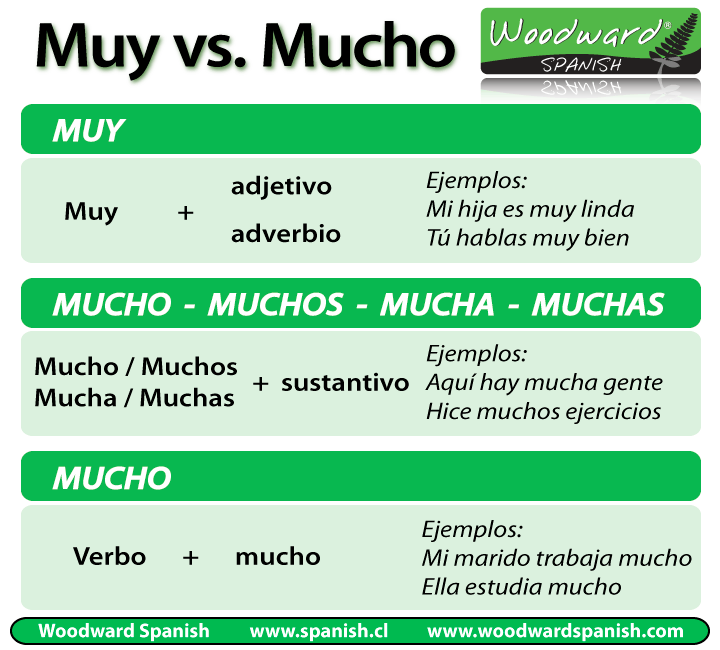Muy vs Mucho
Spanish Grammar Rules
¿Pablo es muy rico? or ¿Pablo es mucho rico?
¿Él tiene muy dinero? or ¿Él tiene mucho dinero?
Knowing when to use muy or mucho in Spanish can be confusing for people learning the language. Below we will show you when to use Muy or Much according to certain grammar rules.
MUY
Muy means Very in English.
Muy is an adverb.
There is only one form of the word Muy. It has no masculine or feminine form and there is no singular or plural form either.
Muy + adjective
You normally use Muy before an adjective to increase the intensity of it.
- Mi hermano es muy alto - (My brother is very tall)
- Mi hermana es muy alta - (My sister is very tall)
- Mis calcetines están muy sucios - (My socks are very dirty)
- Tus amigas son muy locas - (You friends are very crazy)
- Estoy muy enojado - (I am very angry)
Muy + Adverb
Sometimes we use Muy before an adverb
- Yo hablo muy despacio - (I speak very slowly)
- Tú hablas español muy bien. - (You speak very well)
You never use the word Muy by itself. It always needs to be accompanied by an adjective or an adverb.
¿Estás cansado? - (Are you tired?)
– Sí, mucho (we cannot say: si, muy)
– Sí, muy cansado (you need to add an adjective though it may sound repetitive)
MUCHO
Mucho means a lot - a lot of - much - many in English
Mucho can be used as an adjective or as an adverb.
When Mucho is used as an adjective, it must agree both in gender (masc/fem) and number (singular/plural) with the noun.
There are 4 ways of writing Mucho:
- mucho – singular masculine - (a lot, a lot of, much)
- mucha – singular feminine - (a lot, a lot of, much)
- muchos – plural masculine - (a lot, a lot of, many)
- muchas – plural feminine - (a lot, a lot of, many)
Mucho + Noun
Mucho (or its variation) normally goes before a noun.
Examples of mucho, muchos, mucha, muchas:
- Tengo mucho trabajo - (I have a lot of work)
- Hace mucho calor - (It’s really hot)
- Hay mucha comida en la mesa - (There’s a lot of food on the table)
- Ella tiene mucha paciencia - (She has a lot of patience)
- Mi hijo tiene muchos zapatos - (My son has a lot of shoes)
- Necesito muchos vasos para la fiesta - (We need many glasses for the party)
- Mi hija tiene muchas amigas - (My daughter has many friends)
- Hay muchas casas viejas en mi barrio - (There are a lot of old houses in my neighborhood)
Verbo + mucho
Sometimes mucho is used as an adverb and comes after the verb.
The form of Mucho is always the same and there is no change in gender or number.
- Estoy muy satisfecho, he comido mucho - (I’m full, I have eaten a lot)
- Mi hijo está muy cansado porque estudió mucho - (My son is very tired because he studied a lot)
- Mi esposo trabaja mucho - (My husband works a lot)
¿Mucho Trabajo or trabajo mucho?
Both ways are correct though they have two different meanings.
Tengo mucho trabajo – Mucho (adjective) Trabajo (noun)
= I have a lot of work (to do at my job).
Trabajo mucho – Trabajo (verb) Mucho (adverb)
= I work a lot
Muchísimo
You can use muchísimo to emphasize that something is MORE THAN a lot.
It is like saying “very, very” OR “lots and lots of” OR “many, many”.
Again, the word needs to agree both in gender and number:
Muchísimo – Muchísimos – Muchísima – Muchísimas
- Esta mañana hace muchísimo frío. - (It’s very, very cold this morning)
- Ese candidato necesita muchísimos votos para ganar. - (That candidate needs lots and lots of votes to win)
- Tengo muchísima sed porque corrí 10 kilómetros. - (I’m very, very thirsty because I ran 10 kilometres)
- Hubo muchísimas personas en el concierto. - (There were many, many people at the concert)
In English you can say “Very much” however in Spanish you cannot join those two words together and say Muy Mucho. You either use Muchísimo or just Mucho.
Expressions with Mucho
Mucho is also used in these expressions:
- Mucho gusto – Nice to meet you (used after meeting someone)
- Muchas gracias – Thank you (to show your appreciation)
The Opposite of Mucho
The opposite of Mucho is Poco. Just like with Mucho, the adjective Poco also needs to agree both in gender and number.
- Mucho – Poco
- Muchos – Pocos
- Mucha – Pocas
- Muchas – Pocas
Summary Chart
Below we have a summery chart of Muy vs Mucho.

Next Activities
Ver nuestros apuntes de Muy vs Mucho en Español
Try our game about Muy vs Mucho or our other game about Mucho, Muchos, Mucha, Muchas.
If you found this Spanish grammar guide about Muy vs Mucho interesting or useful, let others know about it.

